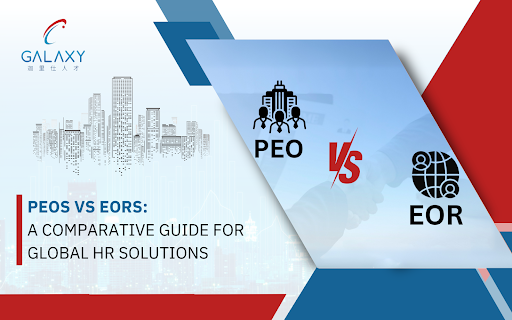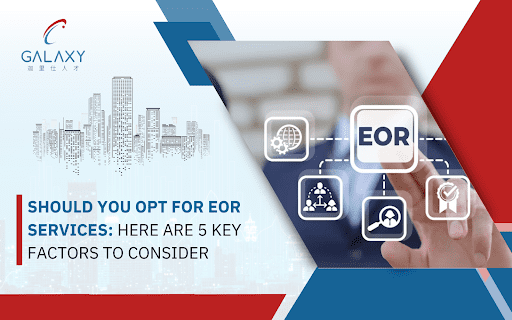PEO vs EOR : A Comparative Guide for Global HR Solutions

PEO vs EOR: A Comparative Guide for Global HR Solutions
The prompt and unified world economy today presents varied options for businesses to accelerate across continents and resort to different services to simplify their administrative processes.
Hiring and managing the international workforce is one of the biggest challenges businesses encounter during expansion. It involves compliance with state or country-specific laws and regulations, handling payroll, onboarding and managing the workforce, termination, paying taxes, etc. Therefore, to save time and cost, organisations resort to HR outsourcing solutions like Professional Employer Organization (PEO) and Employer of Record (EOR).
Both PEO and EOR have gained substantial traction across the global business landscape. As indicated by Straits Research – the global PEO market size was valued at USD 66.23 billion in 2024 and is expected to reach USD 152.14 billion by 2033. It is also expected to grow at a CAGR of 12.3% during the forecasted period (2022 to 2033) in the APAC region. (Read more….)
Countries like Thailand, Indonesia and China have seen increased adoption of EOR services due to their complex labour laws.
Although PEOs and EORs differ in terms of operations and both cater to different specific needs, they are nevertheless advantageous in simplifying business operations. However, employers might get confused about which one to opt for.
This article details the functional similarities, key differences, and various considerations when choosing a PEO or EOR which best aligns with your talent needs.
Parallel Functions of a PEO and an EOR
PEOs and EORs generally perform parallel functions because both help businesses manage employment and HR-related tasks. Let’s have a look at the similar functions performed by them:
Ø Payroll and Tax Filing: Manages payroll, salary calculations, tax deductions, and disbursements also ensures compliance with local tax regulations.
Ø HR Administration: Facilitates hiring, visas & work permits, onboarding, performance management, termination, policy enforcement, etc.
Ø HR Compliance: ensures compliance with local labour laws and tax regulations.
Ø Employee Benefits Administration: offer and manage benefits like health insurance, retirement plans, and other perks.
Ø Risk Mitigation: Minimises risks associated with employment, such as wrongful termination or workplace disputes.
Key Differences between a PEO and an EOR
Even though PEO and EOR service providers help employers, they also possess functional differences where their roles and legal responsibilities significantly differ. Let’s find out the key differences between them in these areas:
1. Definitions
PEO: A PEO is an outsourced partner of a business entity hired to co-employ and manage the workforce and provide other HR support services.
EOR: EOR is a third party service provider who takes charge with the legal responsibilities around employment related services, in a specified country. This arrangement allows businesses to hire workers in countries where they don’t have a legal entity.
2. Legal Employer and Employment Contracts
An EOR acts as an official legal employer of the employees. It hires employees on behalf of the parent employer (the client) and as the legal employer, the EOR signs the employment contracts directly with the employees. In this manner, the EOR assumes full legal responsibility and must be compliant of local labour laws and employment regulations.
PEOs on the other hand, operate as co-employers. The Client Company retains the legal employer status and signs the employment contracts with the employees. While the PEO manages the HR functions under a co-employment agreement. It shares the legal responsibility of the employees with the Client Company.
3. Accountability
It is the sole responsibility of the Employer of Record to ensure compliance with state-specific labour laws, tax regulations, and other statutory requirements. Therefore, it is fully accountable for employment risks like wrongful termination, misclassification, and non-compliance of local labour laws.
The PEO cannot be held fully liable for any risk or wrongful act of the Client Company as it only facilitates compliance and reduces administrative burdens; significant liability thus remains with the Client Company.
4. Scope of Hiring
EORs are particularly useful for companies looking to hire international employees. The EOR enables their customers to expand easily to new countries without having to establish a legal entity, thus allowing them needful bandwidth for core operations.
PEOs generally operate within the same country or region and support businesses in hiring and managing the workforce.
5. Payments to Employees
Being an official legal employer, an EOR ensures direct payment to employees in the local currencies. Unlike EOR, a PEO might not be authorised to pay the employee directly and payments still have to be transferred through the Client Company’s account.
Here is a quick snapshot of the differences between a PEO and an EOR:
| Aspect | PEO | EOR |
|---|---|---|
| Definition | Co-employer managing HR functions. | Legal employer for workforce in a country. |
| Legal Employer | Company retains legal employer status. | EOR is the legal employer. |
| Accountability | Shared compliance, liability on the Client Company. | Full compliance and liability on the EOR. |
| Scope | Domestic hiring support. | International hiring, without need for an entity. |
| Payments | Facilitates payments via the Client Company. | Direct payments to the employee, in local currencies. |
Why Would Businesses in APAC Need PEO and EOR Services?
Well known as a region of dynamic economies, grouping of diverse & complex labour laws, and compelling talent pools, the Asia Pacific region delivers unique opportunities (and challenges) for businesses. Countries like China, Japan, Thailand and Indonesia have distinct regulations and economic conditions that require customised HR solutions.
Choosing Between a PEO and an EOR
Businesses must analyse their need for international expansion, legal compliance and operational control to make an appropriate decision.
Co-employ a PEO if:
- You have an established business or entity in the target country.
- You need HR support while retaining control over your workforce.
- Your aim to enhance operational efficiency, employee satisfaction and reduce administrative burden.
Partner with an EOR if:
- You aim for international expansion and want to hire employees in a different country without setting up a legal entity there.
- You aim to probe before making a long-term investment.
- You wish to remain focused on the core operations of your business.
Conclusion
Small or big, every business faces challenges in workforce expansion and management. PEOs and EORs have distinct advantages for businesses finding employment solutions.
A PEO is ideal for domestic businesses looking to enhance their HR operations while maintaining control over their workers. On the other hand, an EOR is perfect for quick market entry, where businesses want to hire employees without going through the hassle of setting up a legal entity.
The scope of operations and the level of control a company wishes to retain over their workforce must align well with the service they decide to choose. By understanding the distinctive features of EOR and PEO, the customer can make a better informed decision.
Partner with Galaxy and experience our best-of-class customer service coupled with deep local knowledge around Human Resource and corporate services across the Asia Pacific region.
Check out this post on How to Hire International Employees : A Comprehensive Guide
FAQ’S
1.Can a PEO help in hiring in multiple countries?
PEOs are ideal for businesses already operating in a country and want to outsource their HR management operations. Some PEOs might offer services across different countries and facilitate international hiring.
2.Which model offers the Client better control over their employees: the PEO or EOR?
A PEO offers the Client Company more control over their employees in respects to hiring, termination and legalities. With an EOR, the client company has substantial control over their employees but the EOR has the ultimate responsibility to execute the legal aspects relating to hiring, termination and local law compliance.
3. What are the main advantages of using an EOR over a PEO?
The EOR solution provides access to overseas talent and compliance security in a foreign country where the Client Company does not have practical reach. The EOR thus takes full legal responsibility for all related employment, taxes and payroll. This is a popular solution with businesses who want to gain quick entry into a foreign market and overseas workforce. The PEO on the other hand offers more of a HR outsourcing support service when managing a domestic in-country workforce.



